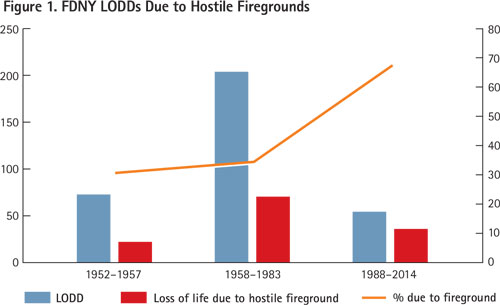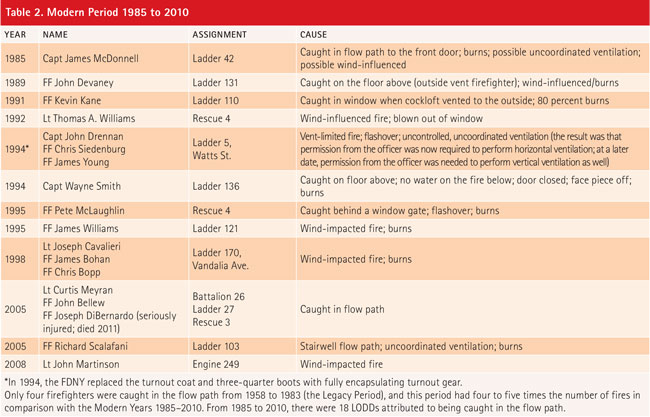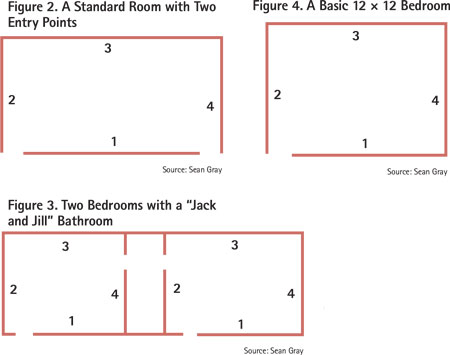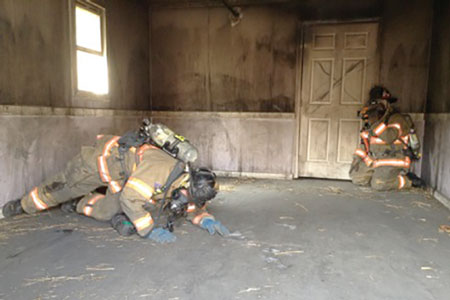
By Sean Gray, P.J. Norwood, and John Ceriello
As our firegrounds continue to evolve through research-based tactics, there is one question that remains: What about the victim? How will these new-age tactics affect the victim? These questions involve tactics from door control to exterior water application.
Many departments across the world have used firefighter safety research to increase their knowledge base and assist in making tactical decisions. Many of the tactical decisions made today differ from those made 20 years ago. For example, many of us were taught never to attack from the burned side – to fight fires from the unburned to the burned side – based on experience. Our new understanding of fire dynamics, however, has revealed the benefits of attacking from the burned side when it is needed. This tactical option has created a number of positive debates and discussions throughout the fire service.

There are many strong opinions, and we do not have the complete answer. The UL Firefighter Safety Research Institute (UL-FSRI) is conducting a grant-funded study on fire attack. This research will help answer some of the questions pertaining to victim survivability in relation to hose stream application.
The questions regarding victim survivability are plausible; we should evolve our tactics to keep up with the evolving fireground. We may never have all of the answers we’re looking for; therefore, based on the current state of knowledge, we can take some steps to enhance victim survivability and firefighter safety in the meantime.
Have you ever examined line-of-duty-death (LODD) reports or firefighter injury statistics in relation to civilian fatalities? Captain John Ceriello of the Fire Department of New York (FDNY) has done extensive research on LODD/injuries vs. civilian fatalities at the FDNY-Mand Library.

Two 25-year periods were examined – from 1958 to 1983 and from 1985 to 2010. In the first period (1958-1983) were the “War Years” (1966 to 1977), during which there were five times as many fires as in the other time periods. FDNY LODDs averaged 6.2 per year in those periods.
Ceriello focused only on members killed as a result of being caught in the flow path of extreme temperatures; other causes of deaths and injuries are too numerous and are not related to fire dynamics.
Why the Increase in Deaths?
What are these data telling us? Is bunker gear or personal protective equipment (PPE) to blame? Does the new PPE encourage firefighters to go too far into the fire structure? Captain Wayne Smith (1994) was the last FDNY member to die without bunker gear; Firefighter Pete McLaughlin was the first to die with bunker gear. Eight LODDs were noted before bunker gear and seven after bunker gear. This is not an overwhelming average. There must be other reasons for these deaths.
Could it be that we are employing old-school tactics within the modern fire environment? There were no civilian deaths at any of these fires where LODDs occurred. There is one recorded rescue of a civilian in a wheelchair from the adjoining apartment in the Vandalia Ave. fire that killed three firefighters. The last time civilians died in the same fire a firefighter died in was in 1980, when Chief Frank T. Tuttlemundo, Battalion 44, lost his life.

In 1980, there were two reported fires where the fallen firefighters may have laid down their lives to protect other firefighters. Lieutenant Robert R. Dolney, Engine 332, and Chief Tuttlemundo protected other firefighters by pushing them out of the way of the flow path and died as a result.
The number of LODDs attributed to a hostile fireground slightly more than doubled from the period of 1958 to 1983 (33 percent) to that of 1988 to 2014 (67 percent). It is worthy to note that the increase from the period 1952 to 1957 and that of 1958 to 1983 was three percent.
 |
| Numbering the walls keeps all members of the search team on the same page and enhances communication between the TIC firefighter and the search firefighter. |
The numbers show that the fireground is getting more hostile. Yet, our tactics have not evolved with the changing fire dynamics of modern fires. The FDNY saw these data as extremely important and set out to do something about the situation. Its approach was to bring its standard operating procedures (SOPs) in alignment with those needed for combating modern fires and to implement the Known vs. Suspected Life Hazards concept.
The data show that most civilians are getting out of the fire building. Consequently, adjustments were needed to help improve firefighters’ chances of escaping from the fire building.
Known vs. Suspected Life Hazards Concept
Size-up on the fireground is critical. Take time to make time! Generally speaking, we should search ahead of a charged hoseline only when there is a known life hazard, meaning that you see or hear something to indicate a victim or that a credible source/person at the fire scene indicates the location of the life hazard.
Does that mean that we do not risk anything and do not go inside when we have a suspected life hazard only? Absolutely not! However, we will need to temper our aggressiveness and keep it in alignment with the benefit. We have all had a situation where we did not have a known life hazard and we made a grab. That’s why we still need to search for the fire and the possible victims.
Have you ever been on the fireground when a firefighter was trapped? If so, did you notice how all of our resources go to the trapped firefighter and the unfound victim gets kicked to the curb?
This raises the question, “Are we truly concerned about the victim?” We are confident that our answer is a resounding yes, but we can do more. We need to focus on the big picture and put programs and protocols in place.
 |
| (1) When searching, have the firefighter with the TIC stay at the door. This firefighter will control the door, direct the searching firefighter, and conserve his air supply. (Photo by Chris Baines.) |
If we are truly concerned about the victim, we should be doing the following in the communities we serve:
- Create a Close-the-Door campaign in public safety education programs.
- Implement dispatch instructions to close exterior doors when exiting.
- Create programs for installing smoke detectors and carbon monoxide alarms.
- Educate the public on the value of residential sprinkler systems.
- Introduce neighborhood cardiopulmonary resuscitation (CPR) and first-aid programs.
- Evaluate community risk through community risk-reduction programs.
- Actively preplan high-risk residential fire districts, and put in place a system that shares data with all responding companies.
Create search and rescue training that focuses on vent-enter-isolate-search and victim removal.
- Take building inspection seriously: Look for the dangers that get civilians and firefighters killed.
Many organizations will view the above recommendations as actions that are the responsibilities of the administrative and fire prevention staff. However, we must remember that water boils from the bottom and the cream rises to the top. Change can be made from every level within the organization.
Interim Modifications
Following are some changes that you can make involving search procedures and your crews while waiting for the big-picture revisions to be addressed:
- Have a plan. Put together a plan with your crew before the fire. Indicate details such as who will be the lead search firefighter, who will carry the thermal imaging camera (TIC), and who will be the lead firefighter in a VEIS operation.
- Number the walls. Wall 1 is the wall that has the entranceway; proceed to the left/clockwise. This standardized system helps firefighters to stay oriented while searching and keeps all crew members on the same page.
- Control all flow paths. Control the front door, and isolate interior bedroom doors, controlling the smoke from possible victims.
- Flow water for the win. Many of us have been taught never to flow water on smoke. What you need to remember is that today’s smoke is not like our grandfathers’ smoke. Today’s smoke is black fire waiting to light off. Dark, turbulent, angry “smoke” must be cooled with water.
- Decision making. What can you do faster: take the problem away from the victim or take the victim away from the problem? Train by timing yourself on hose deployment and search techniques. Refining your skills will make you faster.
At the end of the day, the victim needs to be the number-one priority. However, that doesn’t mean we can be overly aggressive and make poor tactical decisions, which could result in a negative outcome. Using research-based tactics could allow us to make better tactical decisions that result in better outcomes for the victims and fewer injuries or deaths on the fireground. Be smart. Go out and do some training!
SEAN GRAY entered the fire service in 1993 and is a lieutenant with Cobb County (GA) Fire and Emergency Services in Metro Atlanta. He is an appointed member to the UL Fire Safety Research Institute advisory board; was a Technical Panel member for its Study of Residential Attic Fire Mitigation Tactics & Exterior Fire Spread Hazards; and is a member of its Technical Panel for the Study of the Fire Service Training Environment: Safety, Fidelity, and Exposure. He participated in the Illinois Fire Service Institute Cardiovascular & Chemical Risks of Modern Firefighting research study. He has a bachelor’s degree in fire safety engineering from the University of Cincinnati. He has been published in Fire Engineering, is an FDIC H.O.T. lead instructor, and delivers lectures on evidence-based tactics across the United States.
P.J. NORWOOD is a deputy chief training officer for the East Haven (CT) Fire Department and has served four years with the Connecticut Army National Guard. He is an FDIC classroom, workshop, and H.O.T. instructor; a Fire Engineering educational advisory board member, and a Fire Engineering book and video author. He was a member of the UL Technical Panel for the Study of Residential Attic Fire Mitigation Tactics and Exterior Fire Spread Hazards on Fire Fighter Safety. He has lectured across the United States and overseas. Norwood is certified to the instructor II, officer III, fire marshal, and paramedic levels.
JOHN CERIELLO is a 28-year veteran of the Fire Department of New York City (FDNY); he had been assigned to Special Operations Command for 14 of those years. He is now a captain in the 11th Division. He has been an integral part of the FDNY and National Institute of Standards and Technology wind-impacted fires project that introduced stairwell pressurization, wind-control devices, and high-rise nozzles into the field. He was part of the team that implemented new concepts of ventilation and flow path control in the FDNY. He is on the Underwriters Laboratories advisory panel for a number of projects, including those on horizontal and vertical ventilation and attic fire research.
Sean Gray; P.J. Norwood; John Ceriello; and the Stop Believing, Start Knowing instructor cadre will present “Working in the Fire Flow Path” H.O.T. evolution at FDIC International on Monday April 24, 2017, and Tuesday, April 25, 2017, 8:00 a.m.-12:00 p.m. and 1:00 p.m.-5:00 p.m.
Sean Gray will present “Attack from the Burned Side” at FDIC International in Indianapolis on Wednesday, April 26, 2017, 1:30 p.m.-3:15 p.m.
P.J. Norwood will present “The Evolving Fireground: Evidence-Based Tactics” at FDIC International in Indianapolis on Wednesday, April 26, 2017, 3:30 p.m.-5:15 p.m.
Survivability Profiling: Are the Victims Savable?
WHERES THE VICTIM?
REMOVE THE IDLH, NOT THE VICTIMS
Fire Engineering Archives

